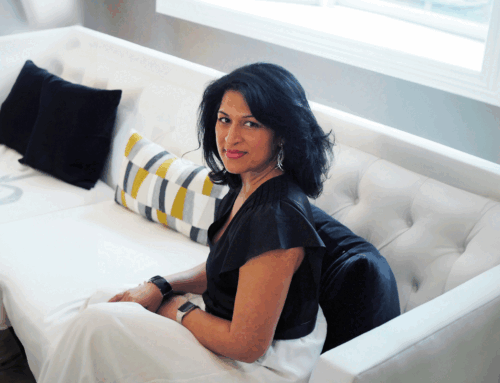Writing by Aerin Atinsky
Photography by Justin Negard
“Hats are definitely back—from Alicia Keys to Bruno Mars and Lady Gaga, hats are back,” exclaims milliner Jackie Cicogna, a Somers resident. “We’re done with the COVID sweats; we’re ready to play dress up again. We are seeing the comeback a lot in Europe, and now the United States.”
At the age of 20, Jackie Cicogna designed a hat that caught the eye of fashion designer Donna Karan. At the time, she was studying fashion design at the Fashion Institute of Technology (FIT) and working part time at Hat Attack in Manhattan.
“I was working in their office, but they’d seen my work,” she remembers. “They told me that Donna Karan wanted some hats with a new fabric called cotton lycra, and they asked me if I wanted come up with some ideas. Somehow, I came up with this beret, and she loved the beret. I created the pattern, but no one in their production department could sew it. So, they asked me if I could make them at my home if they cut the fabric for me. They said they’d pay me for my time. I said, ‘Okay.’”
“They sent boxes and boxes to my apartment in Queens,” she continues. “They would drop off boxes of cut fabric, and I just sat at my machine and made the hats. I would sew a hat, drop it in the box, and then they would come pick up the box and drop off more fabric. I made the first 3,000 of those berets by hand in my apartment.”
Cicogna sells a very similar version of this beret today – it’s named Donna, of course.
The granddaughter of a custom milliner for Bergdorf Goodman and a coat seamstress, Cicogna grew up immersed in fine arts – loving sculpture, drawing and painting. Mainly raised in New York (she spent most of elementary school in southern France), she originally planned to pursue fine arts at Parsons School of Design. But, as she was only 17 years old when it was time to begin college, her father convinced her to delay it for a year and spend that time with him in Hong Kong. While there, she took several art classes and, at his insistence, she applied to FIT. To her surprise, she was accepted, and he convinced her to attend.
When it was time to sign up for classes, she saw they offered a millinery course as an elective.
“It reminded me of my grandmother, and I knew I needed to take that class,” Cicogna explains. “I loved it, and I took a millinery class every single semester, always with the same teacher because I preferred her style.”
Cicogna studied under Janine Gallimard – Cristobal Balenciaga’s milliner throughout the 50s and 60s.
“She taught me techniques I couldn’t have even imagined,” says Cicogna. “FIT was a fantastic, intense experience and the teachers are hardcore — you have to get your work done, and it has to be perfect. But I’m a perfectionist anyway, so I always made sure what I was doing was my best, and I had such good fortune with my teachers.”

Establishing a brand
After college, Cicogna launched her own brand: Jacqueline Cicogna Millinery while working at Lola Hats in Manhattan.
“It was tough, but I was in my twenties, so I think that made it less scary,” she remembers. “I only had to take care of myself. I did a bunch of cold calls to brands and individual clients who I wanted to sell hats to.”
Cicogna made luxury headpieces, like combs and headbands, as well as bridal pieces, specializing in feather colors. She worked with silk, beads, pearls, gemstones and more, building a reputation that landed her clients like Bergdorf Goodman in Manhattan and Ultimo in Chicago. Her work was featured in The New York Times, Vogue Italia and Paper Magazine.
But after four years, Cicogna moved to Paris with her boyfriend.
Unexpected turns
In Paris, Cicogna worked with a milliner for a year before he closed his shop. Then, after a brief stint at a hotel, she became a sales assistant in Paul Smith’s wholesale department. There, she says she found “a second family.” And although she hadn’t planned to stay in Paris for longer than a couple of months, Cicogna spent nine years at Paul Smith before taking time off to raise her two children.
But just a year later, she was recommended for a job at Ralph Lauren, which she got. Eventually, she moved on to Prada.
“These experiences helped me better understand what a full collection was, and I learned a whole other level of customer service and business management,” she remembers. “These new skills became a huge asset when I relaunched my business.”
In 2015, Cicogna finally returned home to work at the CELINE flagship store in Manhattan, and she was reunited with her millinery equipment, which her family had placed in storage when she left. She wondered if she could still make a hat, so she tried. It all came back to her, and when she was furloughed from her management role at Giorgio Armani in 2020, she made the leap to rebuild her business, this time shortening the name to Jackie Cicogna Millinery.
“It was a huge leap of faith, and I didn’t know how I was going to cover everything,” Cicogna recalls. “I had the advantage of unemployment coverage from the government and the most amazing family ever. I’m so grateful for my family and friends; I would never be able to do this without them.”

Building an experience
“Millinery has emotive value – it’s an art,” says Cicogna. “Whenever I’m working with a client, it’s a very emotional thing. A hat is not like any other piece of clothing, it’s something very special — it covers your head, it protects you, and it becomes part of who you are.”
The process of buying a custom hat is a personal one. Cicogna meets with her clients to learn their measurements, tastes and lifestyle. She also asks them to try on several hats so she can learn what they’re looking for.
“Buying a hat becomes an experience,” she explains. “From beginning to end, it’s created for that specific person, and they go through the creative process with me. Their hat is unique, and it holds something special for them — no one else has it. It’s created exclusively for their face.”
Cicogna makes ready-to-wear winter hats out of soft felts and other “winter-y fabrics,” summer hats out of a variety of straws and lightweight materials, white satin bridal hats with veils of land crystal, pearl-beaded bridal crowns, jeweled and floral combs, and occasionally, children’s hats. She also makes hats for special events like the Kentucky Derby or Greenwich polo games, which can become elaborate works of art featuring handmade flowers on top or hand-embroidered lace with crystals on the veils.
Her client base runs the gamut—men and women, young and old, turn to Cicogna for custom headwear that compliments their face and their personality. Her ready-to-wear/made-to-order hats range in price from $150 to $850, and her custom hats range in price from $850 to $2,500.
“I cater to many professionals and independent people—lawyers, politicians, interior designers, graphic designers, entrepreneurs and artists like myself who just appreciate the artistry,” explains Cicogna. “But I also make hats for moms and dads who want to spend a little more on a beautiful custom-made hat. And lately, I’ve been making hats for teens as well.”
For Cicogna, the best part of the process is when a hat is complete and her client tries it on for the first time. Their reaction to their new, custom hat inspires her.
“Their eyes light up, and they tell me they feel transformed,” she says. “They’ll say their new hat gives them confidence and they feel beautiful, handsome or glamorous. That’s what keeps me going.”
And what truly baffles Cicogna are the people who choose to spend the same amount purchasing overpriced, mass-produced designer sunglasses.
“You can spend a thousand dollars on a pair of designer sunglasses that millions of people across the world are wearing,” she says. “Or you can help design your own custom, luxury, high-quality hat that’s made by an artisan and only you have. I think if people are paying equivalent prices, they should be getting that unique experience and quality.”
She says her clients have told her that their hat becomes a family heirloom and a prized possession.
“People have compared my hats to those luxury brands like Armani and Stephen Jones, which is a tremendous honor.”

The future includes hats
“What’s really exciting for me is that now, young kids, starting at age 16, are coming to me, too,” says Cicogna.
As the industry, and her business, continue to grow, Cicogna hopes to move to a larger space, train and hire other milliners and work collaboratively with designers.
“Hats are not just another accessory like a handbag or pair of shoes,” says Cicogna. “Hats are a beauty and a wellness product — they keep you warm and protect your head in the wintertime, protect your skin in the summer, make you look great in a selfie, and they will even hide your messy, unwashed or gray hair.”
“Throw on a hat and you will look polished, put together and instantly chic.”

This article was published in the March/April 2023 print edition of Katonah Connect.
The Artistry of Hat Making
Cicogna sources her material mostly from ManhatCo in New York City, a company she’s maintained a relationship with for almost 30 years.
“I have this obsession with textiles, fabrics and textures, so walking into that place is like walking into heaven for me,” says Cicogna. “I need to touch and feel, and see novelties and newness, like waterproof felt and crazy patterns.”
She sources other materials – like flannel, cotton and sewing supplies – locally. There are a few specialty items that she purchases from stores in the Midwest, and, occasionally from certain shops in the United Kingdom and Germany.
For both straw and felt hats, Cicogna first softens the material by either dampening or steaming it. Then, she blocks it over a crown. Next, she ties the material with the equivalent of a tourniquet, but made from rope, and lassos the material in order to cinch it and pin it around a wooden block. She then cuts the off excess, which becomes the hat’s brim.
Once those steps are complete, Cicogna attaches the future brim to what she calls a head size, which is simply the client’s head size made from a piece of buckram. Then, the client returns for a fitting so Cicogna can confirm the hat will be comfortable – sometimes, they want it a bit tighter or looser than the standard fit. Together, they’ll determine the height of the crown and the exact size of the brim.
Then Cicogna shapes brim. If she’s creating a hand-shaped brim, which is typical for a custom hat, she uses a tool called an iron egg.
“It’s basically exactly how it sounds — it’s a cast iron egg on a stick that I heat up,” she explains. “Iron creates steam, and the steam softens the material and shapes the hat at the same time.”
When she doesn’t use the egg, she’ll block the rim on a brim block.
Depending on the finishes, Cicogna can leave the hat with a raw edge, sew a wire on the end, add a hand-sewn grain finish, or more. Before she attaches the crown to the brim, Cicogna hand sews the hat’s sweatband that lines the forehead.
Then, she completes the trim of the hat and writes a personal message to the client. If someone is purchasing a hat for someone else, she’ll write the message from the gifter. While the message is often meaningful to the client, it also serves a functional purpose: it tells them which way to wear their hat (the message goes in the front).
“And then, and only then, is the hat complete.”
Depending on the hat and material, the process can take from three to 30 hours. Cicogna also includes hat renovations in her services.
When she doesn’t use the egg, she’ll block the rim on a brim block.
Depending on the finishes, Cicogna can leave the hat with a raw edge, sew a wire on the end, add a hand-sewn grain finish, or more. Before she attaches the crown to the brim, Cicogna hand sews the hat’s sweatband that lines the forehead.
Then, she completes the trim of the hat and writes a personal message to the client. If someone is purchasing a hat for someone else, she’ll write the message from the gifter. While the message is often meaningful to the client, it also serves a functional purpose: it tells them which way to wear their hat (the message goes in the front).
“And then, and only then, is the hat complete.”
Depending on the hat and material, the process can take from three to 30 hours. Cicogna also includes hat renovations in her services.











